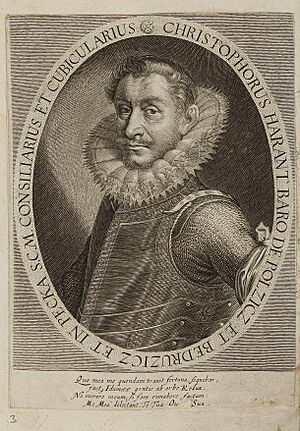Kryštof Harant facts for kids
Kryštof Harant of Polžice and Bezdružice (1564 – June 21, 1621) was a Czech nobleman, explorer, writer, and composer. He was also a soldier and a humanist, someone who valued human achievements and potential.
Harant joined the Protestant Bohemian Revolt against the House of Habsburg, who were the rulers of the Lands of the Bohemian Crown. This revolt was a major event that helped start the Thirty Years' War. After the Catholic forces won a big battle, Harant was executed by the Habsburgs in a public event in Prague.
As a composer, Harant was known for his style of polyphony (music with multiple independent melodies) in Bohemia. He is also famous for his journey to the Middle East, which he wrote about in his travel book, Journey from Bohemia to the Holy Land, by way of Venice and the Sea.
Contents
Early Life and Adventures
Kryštof Harant was born in 1564 at Klenová Castle in western Bohemia. When he was about 12 years old, in 1576, he began studying music. He learned singing and counterpoint (a way of combining melodies) at the court of Archduke Ferdinand II in Innsbruck. During this time, he learned seven different languages! He also discovered his talents in music and other arts. He became very interested in history, geography, and politics.
In 1584, Harant returned to Bohemia. He tried to get a job at the court of Emperor Rudolf II, but it didn't work out. So, he decided to become a soldier. He fought in military campaigns against the Turks in 1593 and 1597.
Harant got married three times. His first wife was Eva Czernin von Chudenitz. They had two children before she passed away in 1597.
Journey to the Holy Land
In 1598 and 1599, Harant went on an important journey. He traveled to the Holy Land as a pilgrim, meaning he went for religious reasons. He especially wanted to visit the Holy Sepulchre, a famous holy site. He went with his first wife Eva's brother, Hermann.
Harant wrote all about his experiences and adventures during this trip. His book was called Journey from Bohemia to the Holy Land, by way of Venice and the Sea. It was published in Prague in 1608 and became quite famous.
Career and Rebellion
After his journey, in 1599, Harant got a job at the emperor's court. He was also given a higher social rank as a nobleman. He became an advisor to Emperor Rudolf II and later to his successor, Emperor Matthias. He also worked in the imperial chambers, which were important government offices.
When the imperial court moved to Vienna, Harant was given Pecka Castle. For several years, he focused on his music. He became one of the most important Bohemian composers of his time. Between 1614 and 1615, he also traveled to Spain as part of a diplomatic mission.
Joining the Bohemian Revolt
In 1618, Kryštof Harant made a big change in his life: he converted to Protestantism. He then returned to Prague and joined the forces that were fighting against the Catholics. He became an artillery officer and fought for the Bohemian states during their uprising.
In 1619, he became a leader of military units in several towns. He was part of a large army of 50,000 soldiers that marched towards imperial Vienna. During this rebellion, he even fired cannons at the imperial palace in Vienna, where the emperor was staying. This action later caused him trouble.
After Frederick V became the new ruler of Bohemia, Harant was appointed as a special advisor and president of the Bohemian chamber. However, this important job did not last long.
Capture and Execution
In 1620, the Protestant Czechs were defeated at the Battle of White Mountain by the armies of Maximilian and Tilly. After this defeat, Imperial troops took over Prague. The new emperor, Ferdinand II, took power.
Harant went back to his castle, but he was captured there by Albrecht von Wallenstein's forces. He was arrested and taken to Prague. He tried to ask for mercy, but it was denied. Kryštof Harant was one of twenty-seven Bohemian noble rebels who were sentenced to death. He was beheaded on June 21, 1621, by Jan Mydlář in the Old Town Square in Prague, along with all the other leaders of the rebellion.
Music and Legacy
Kryštof Harant's music was considered traditional for his time. It was similar to the style of composers from the Netherlands who lived in the previous generation. He used older techniques, like creating a cantus firmus mass.
Only seven of his musical works have survived. All of them are sacred vocal compositions (music for voices, often for church). The rest of his music was lost when his property was taken away after his execution. One of his famous pieces is a mass called Missa quinis vocibus super Dolorosi martir. It's interesting because it combines an older musical technique with the music of a popular Italian composer named Marenzio.
Harant was also known for being a very good instrumentalist and singer, not just a composer. It's a surprising fact that one of his Roman Catholic masses was performed in a Catholic church in Prague in 1620, just before he was executed.
Surviving Musical Works
- Missa quinis vocibus super Dolorosi martir – This mass is based on a madrigal (a type of vocal music) by L. Marenzio.
- Motet Maria Kron, die Engel schon – This is a five-voice motet (a type of choral composition) with German text, composed in 1604.
- Motet Qui confidunt in Domino – This six-voice motet was composed in Jerusalem in 1598 during his pilgrimage.
The complete collection of Kryštof Harant's works was published in 1956.
Literature
- Journey from Bohemia to the Holy Land, by way of Venice and the Sea (1608) – This is his famous travel book describing his pilgrimage.


